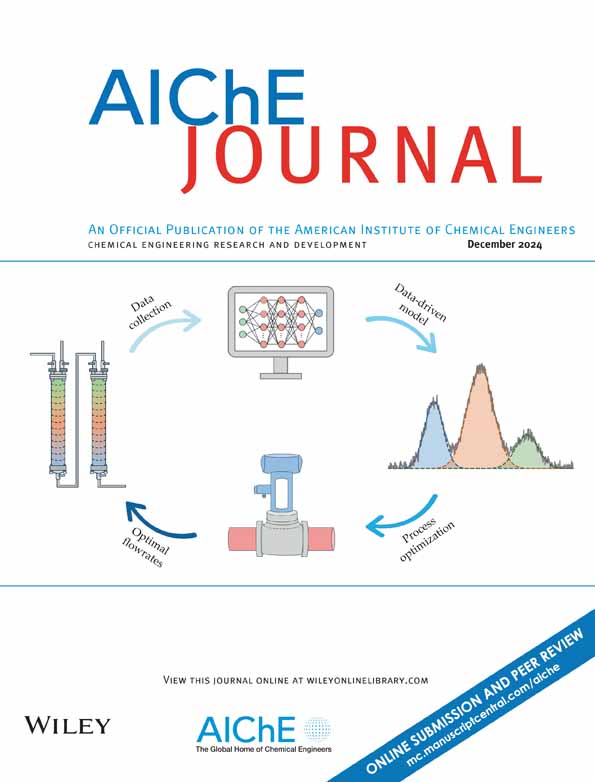Co1Ni单原子合金是一种高效的氨甲基化非均相催化剂
IF 4
3区 工程技术
Q2 ENGINEERING, CHEMICAL
引用次数: 0
摘要
甲醇作为一种通用的N -甲基化试剂,作为一种可获得的溶剂,可持续的C1源和氢供体。然而,传统的利用甲醇的N -甲基化途径通常需要过量的碱添加剂来激活C - H键。在这里,我们开发了一种TiO2负载的Co1Ni单原子合金(SAA)催化剂,该催化剂能够在无添加剂的甲醇体系中对23种胺进行有效的N -甲基化,通过甲酸甲酯途径实现了90%以上的产率。值得注意的是,SAA在使用氘化甲醇构建N - CD3基序以进行六种不同胺的N -三氘甲基化反应方面表现出了出色的能力。动力学研究表明,甲醇脱氢生成甲酸甲酯是反应速率的决定步骤,甲酸甲酯是N -甲基化的关键活性中间体。理论计算进一步表明,在Co1Ni SAA催化剂中,ch30 *中间体在原子分散的Co位点上的独特吸附模式使得ch30 *脱氢的激活势垒较低,为0.26 eV。本文章由计算机程序翻译,如有差异,请以英文原文为准。
Co1Ni single‐atom alloy an efficient heterogeneous catalyst for amines N‐methylation using methanol
Methanol serves as a versatile N ‐methylation reagent, functioning as an accessible solvent, sustainable C1 source, and hydrogen donor. However, the conventional N ‐methylation pathways utilizing methanol usually require excessive alkali additives to activate the C‐H bond. Here, we develop a TiO2 ‐supported Co1 Ni single‐atom alloy (SAA) catalyst that enables the efficient N ‐methylation of 23 types of amines in an additive‐free methanol system, achieving yields over 90% via a methyl formate pathway. Significantly, the SAA demonstrates remarkable proficiency in constructing the N‐CD3 motif using deuterated methanol for the N ‐trideuteromethylation reaction of six different amines. Kinetic studies reveal that dehydrogenation of methanol to methyl formate is the rate‐determining step, and that methyl formate acts as the key active intermediate for N ‐methylation. Theoretical calculations further demonstrate that the unique adsorption mode of CH3 O* intermediate on top of atomically dispersed Co sites in the Co1 Ni SAA catalyst endows a lower activation barrier of 0.26 eV toward CH3 O* dehydrogenation.
求助全文
通过发布文献求助,成功后即可免费获取论文全文。
去求助
来源期刊

AIChE Journal
工程技术-工程:化工
CiteScore
7.10
自引率
10.80%
发文量
411
审稿时长
3.6 months
期刊介绍:
The AIChE Journal is the premier research monthly in chemical engineering and related fields. This peer-reviewed and broad-based journal reports on the most important and latest technological advances in core areas of chemical engineering as well as in other relevant engineering disciplines. To keep abreast with the progressive outlook of the profession, the Journal has been expanding the scope of its editorial contents to include such fast developing areas as biotechnology, electrochemical engineering, and environmental engineering.
The AIChE Journal is indeed the global communications vehicle for the world-renowned researchers to exchange top-notch research findings with one another. Subscribing to the AIChE Journal is like having immediate access to nine topical journals in the field.
Articles are categorized according to the following topical areas:
Biomolecular Engineering, Bioengineering, Biochemicals, Biofuels, and Food
Inorganic Materials: Synthesis and Processing
Particle Technology and Fluidization
Process Systems Engineering
Reaction Engineering, Kinetics and Catalysis
Separations: Materials, Devices and Processes
Soft Materials: Synthesis, Processing and Products
Thermodynamics and Molecular-Scale Phenomena
Transport Phenomena and Fluid Mechanics.
 求助内容:
求助内容: 应助结果提醒方式:
应助结果提醒方式:


